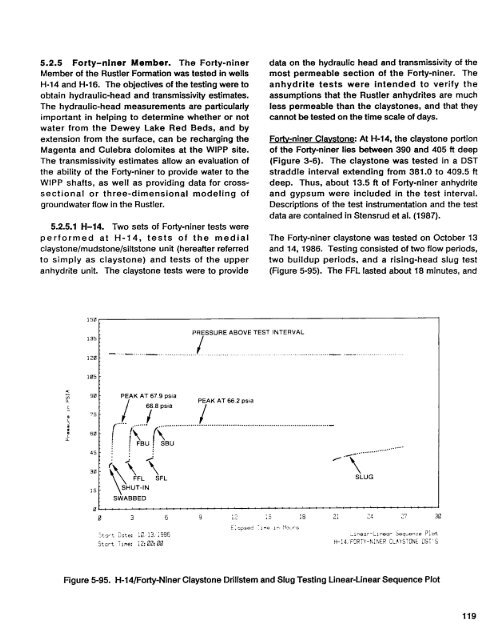Beauheim 1987 - Waste Isolation Pilot Plant - U.S. Department of ...
Beauheim 1987 - Waste Isolation Pilot Plant - U.S. Department of ...
Beauheim 1987 - Waste Isolation Pilot Plant - U.S. Department of ...
Create successful ePaper yourself
Turn your PDF publications into a flip-book with our unique Google optimized e-Paper software.
~<br />
5.2.5 Forty-niner Member. The Forty-niner<br />
Member <strong>of</strong> the Rustler Formation was tested in wells<br />
H-14 and H-16. The objectives <strong>of</strong> the testing were to<br />
obtain hydraulic-head and transmissivity estimates.<br />
The hydraulic-head measurements are particularly<br />
important in helping to determine whether or not<br />
water from the Dewey Lake Red Beds, and by<br />
extension from the surface, can be recharging the<br />
Magenta and Culebra dolomites at the WlPP site.<br />
The transmissivity estimates allow an evaluation <strong>of</strong><br />
the ability <strong>of</strong> the Forty-niner to provide water to the<br />
WlPP shafts, as well as providing data for crosssectional<br />
or three-dimensional modeling <strong>of</strong><br />
groundwater flow in the Rustler.<br />
5.2.5.1 H-14. Two sets <strong>of</strong> Forty-niner tests were<br />
performed at H-14, tests <strong>of</strong> the medial<br />
claystone/mudstone/siltstone unit (hereafter referred<br />
to simply as claystone) and tests <strong>of</strong> the upper<br />
anhydrite unit. The claystone tests were to provide<br />
data on the hydraulic head and transmissivity <strong>of</strong> the<br />
most permeable section <strong>of</strong> the Forty-niner. The<br />
anhydrite tests were intended to verify the<br />
assumptions that the Rustler anhydrites are much<br />
less permeable than the claystones, and that they<br />
cannot be tested on the time scale <strong>of</strong> days.<br />
Fortv-niner Clavstone: At H-14, the claystone portion<br />
<strong>of</strong> the Forty-niner lies between 390 and 405 ft deep<br />
(Figure 3-6). The claystone was tested in a DST<br />
straddle interval extending from 381.0 to 409.5 ft<br />
deep. Thus, about 13.5 ft <strong>of</strong> Forty-niner anhydrite<br />
and gypsum were included in the test interval.<br />
Descriptions <strong>of</strong> the test instrumentation and the test<br />
data are contained in Stensrud et al. (<strong>1987</strong>).<br />
The Forty-niner claystone was tested on October 13<br />
and 14, 1986. Testing consisted <strong>of</strong> two flow periods,<br />
two buildup periods, and a rising-head slug test<br />
(Figure 5-95). The FFL lasted about 18 minutes, and<br />
135 -<br />
1<br />
PRESSURE ABOVE TEST INTERVAL<br />
. -....-......- ............................................................................ -.--<br />
120<br />
lB5 t<br />
c<br />
..<br />
90<br />
ffl a<br />
- PEAK AT 67.9 psia<br />
_r 1 I, .F rr<br />
rchn HI 00.2 psia<br />
L<br />
0<br />
75 -<br />
60 -<br />
45<br />
-<br />
30 -<br />
15:<br />
. .<br />
FFL SFL<br />
PUT-IN<br />
SWABBED<br />
... .......................................................................................... -<br />
.................<br />
........<br />
cL _<br />
0<br />
.\<br />
SLUG<br />
Figure 5-95. H-l4/Forty-Niner Claystone Drillstem and Slug Testing Linear-Linear Sequence Plot<br />
119

















